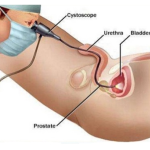What is cystoscopy?
It is a procedure that enables your doctor to view the inside of the urethra and the bladder.
What are the diagnostic indications?
The commonest reason is blood in the urine (hematuria). The causes of hematuria could be urinary tract infection (UTI), stone disease, prostate enlargement (males), new growth (tumor) in the bladder, or from the upper tracts (kidneys and ureter).
How is cystoscopy performed?
It is done in the OT. You will be given intravenous medications by anaesthetists which will make you go to sleep. After a lubricant jelly is injected into the urethra the cystoscope is passed into the urethra and the bladder.
What is a cystoscope?
Cystoscope is a thin, lighted, telescope, to see inside the bladder, and uses saline to open up the urethra and fill the bladder. A video camera can also be attached to the cystoscope, so that the images can be viewed on a television monitor. Different angled lenses on the end of the cystoscope allow the urologist to view the entire bladder.
The entire urethra and bladder can be studied. If any tissue in the bladder wall appears abnormal, a small sample can be taken through the cystoscope for microscopic examination.
The actual cystoscopy time is about 10 to 15 minutes. But it takes an hour or so, in the operation theater. Rarely your doctor may keep a catheter connected to a urine bag which will be removed after a day or two.
Other uses of cystoscopy?
It can be used as part of treatment like
- Removal of bladder stone (cystolithotripsy)
- Visual internal urethrotomy (VIU – to open up the narrow segment of the urethra which is blocked)
- Prostate surgery (TUR-P i.e., Transurethral resection of the prostate) or bladder neck incision (BNI)
- Bladder tumor resection (TUR-BT i.e., Transurethral resection of bladder tumor)
- Injecting drugs into the urethral sphincter or bladder-like Inj. Botox
- Removal of large bladder clot
- To identify and characterize abnormal openings between urinary tract and vagina or rectum
- To remove ureteric stent (which may have been placed after previous surgery like pyeloplasty, ureterorenoscopy or percutaneous nephrolithotomy)
Note: For stent removal in adults, usually, no fasting is required as it is done under local anaesthesia
- To bypass the block in the ureter like due to a ureteric stone called ureteric stenting
- To evaluate the upper tract swelling (hydroureteronephrosis) by injecting contrast material. This test is called retrograde bulb ureterogram. The last 2 procedures will need the use of fluoroscopy (involves radiation)
Do I need to continue regular medications on the day of surgery?
Inform your doctor all the medications you are taking, so that any blood thinners, like Acitrom, Clopilet, may be temporarily stopped. Your diabetic and blood pressure medications may need to be stopped and this will be informed to you by anaesthetists.
Is antibiotic required for diagnostic cystocopy?
If you have a sterile urine culture, no antibiotic is required. But if the urine culture is positive and if we are doing any intervention (even if the urine culture is sterile) antibiotic will be given based on sensitivity or as per hospital antibiotic policy.
Note: If you have an allergy to any drugs, inform your doctor.
What should I expect on the day of procedure?
This is usually performed as a day care procedure. You would need 4 to 8 hours fasting (for solids) prior to the study and this would be intimated to you by the anaesthetists. However, you will be allowed consumption of clear liquids up to 4 hours before the procedure.
The genital area needs to be trimmed of hair. You will be asked to sign a consent form before shifting to theater. You need to change into the hospital gown and cap.
What happens after the procedure?
Most people undergoing cystoscopy will be able to go home the same day as the procedure. Recovery depends on the type of anaesthesia. If an only local anaesthetic is used, you can go home after you pass urine once. For those in whom intravenous sedation was given, a recovery period of 2-4 hours is necessary. During this period, the anaesthetic will wear off, and once you are able to tolerate food orally and pass urine, you will be allowed to go home.
After the procedure, when you pass urine for the first time you may feel a burning sensation or pain while voiding and urine may be mildly blood stained and this may last for up to 48 hours. If discomfort persists, or you get fever or urine appears bright red, your doctor needs to be informed.
When will I know the result of the procedure?
Immediately after the procedure, your doctor will inform the findings to you or your relative. You can talk to doctor later when the anaesthesia effect wears off. If biopsy has been taken, you need to see your doctor with the report usually after a week. If during scopy there is abnormal finding which demands additional procedure (surgery), you will need to fix another date for the surgery as this may need different type of anaesthesia, hospitalization and discussion with you regarding the surgery.
What are the possible complications of diagnostic cystoscopy?
Cystoscopy is generally a safe procedure. Serious complications are rare. As with any surgery, there is the risk of infection, bleeding, and complications from the anaesthesia.
Rarely false passage may occur if there is poor vision and stricture.
Urinary retention (inability to pass urine) can occur after cystoscopy. This will generally require the placement of a catheter to drain the bladder.

